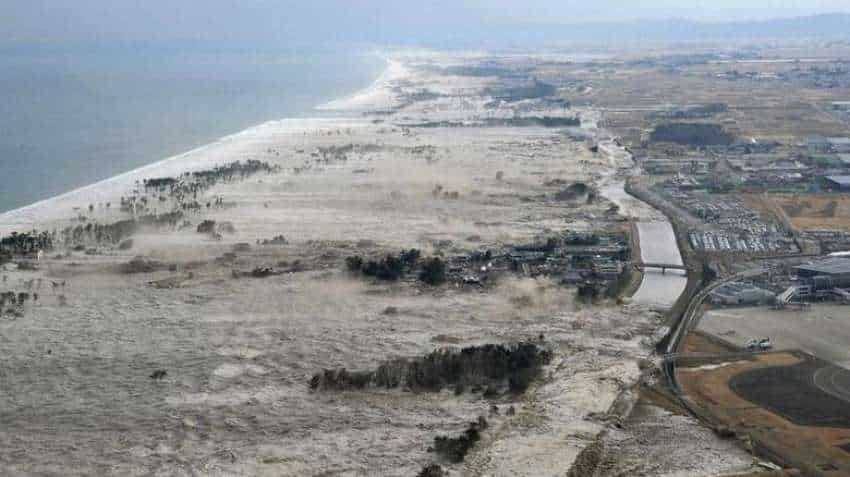Threat of tsunami lurks in offshore KG basin as geological faultline found: Study
The research team, comprising Prof K.S. Krishna and Dr M. Ismaiel from UoH, Dr K. Srinivas from NIO, and Dr D. Saha from ONGC, analysed seismic reflection data to understand the cause-effect relationship between the sediment load and the response of underneath heterogeneous igneous rocks in the Bay of Bengal, the varsity said in a statement, here on Sunday.

Researchers from the University of Hyderabad (UoH), the National Institute of Oceanography (NIO) and the Oil and Natural Gas Corporation (ONGC) have discovered a geological faultline that could trigger a major coastal hazardous event in and around Visakhapatnam.
The research team, comprising Prof K.S. Krishna and Dr M. Ismaiel from UoH, Dr K. Srinivas from NIO, and Dr D. Saha from ONGC, analysed seismic reflection data to understand the cause-effect relationship between the sediment load and the response of underneath heterogeneous igneous rocks in the Bay of Bengal, the varsity said in a statement, here on Sunday.
The study, conducted over three years, found presence of a 300-km-long fracture line in the offshore region of north Andhra Pradesh, about 100 km away from the coastline. In geological sense, the fracture line borders eastern side of the offshore Bastar craton between the Pranahita-Godavari graben in the south and Nagavali-Vamshadhara shear zone in the north.
Located to the east of north Andhra Pradesh, the once repetitively active fracture line has a maximum activity focussed in the vicinity of offshore Visakhapatnam. It might become active again, leading to a tsunami in the region, the researchers said.
According to the study, fracture line activity in the offshore Krishna-Godavari (KG) basin was variable in nature. It had episodic start about 16 million years ago, which resumed around 6.8 million years ago. From then, the activity continued until 0.3 million years ago.
Excessive vertical throws occurred at 16-6.8 million years ago over a distance of 300 km offshore north Andhra Pradesh that might have triggered the seismicity and prompted generation of intensive tsunami events.
The fracture line, currently inactive, may become active in case of the differential stresses on either side of the fracture line reaching the threshold level, and may turn out to be a geo-hazard event. While it`s not easy to predict the timing of future activity, the researchers said the activity would certainly reoccur in a short time (in the geological sense).
Watch Zee Business live TV below:
"It`s in the dormant stage. The activity may reoccur any time in the geological sense -- maybe in hundreds of years or even thousand years or more than that. Right now, people do not have to worry. I don`t want to create panic, but when the Sumatra tsunami happened, no one thought about that. It suddenly happened one fine day," Prof Krishna told IANS.
The study was reported in the recent issue of Journal of Earth System Science, published by the Indian Academy of Sciences.
Get Latest Business News, Stock Market Updates and Videos; Check your tax outgo through Income Tax Calculator and save money through our Personal Finance coverage. Check Business Breaking News Live on Zee Business Twitter and Facebook. Subscribe on YouTube.
RECOMMENDED STORIES

Small SIP, Big Impact: Rs 1,111 monthly SIP for 40 years, Rs 11,111 for 20 years or Rs 22,222 for 10 years, which do you think works best?

Rs 3,500 Monthly SIP for 35 years vs Rs 35,000 Monthly SIP for 16 Years: Which can give you higher corpus in long term? See calculations

SCSS vs FD: Which guaranteed return scheme will give you more quarterly income on Rs 20,00,000 investment?

Power of Compounding: How long it will take to build Rs 5 crore corpus with Rs 5,000, Rs 10,000 and Rs 15,000 monthly investments?
03:09 PM IST










 ONGC draws a blank on offer of stake in Deen Dayal gas field
ONGC draws a blank on offer of stake in Deen Dayal gas field Petroleum Minister Hardeep Puri hails ONGC after share price skyrockets to all-time high
Petroleum Minister Hardeep Puri hails ONGC after share price skyrockets to all-time high ONGC starts oil production from delayed USD 5 billion deep-water project
ONGC starts oil production from delayed USD 5 billion deep-water project  After Exxon and Chevron, France's Total signs up for ONGC acreage
After Exxon and Chevron, France's Total signs up for ONGC acreage ONGC Q2 Results: Net profit drops 30% to Rs 12,826 crore as govt levies windfall tax
ONGC Q2 Results: Net profit drops 30% to Rs 12,826 crore as govt levies windfall tax